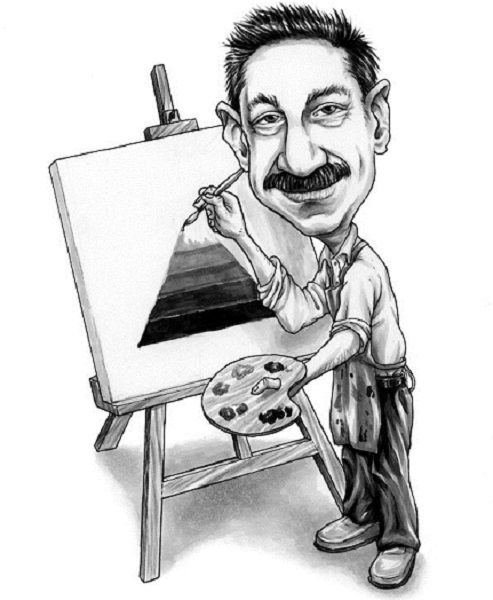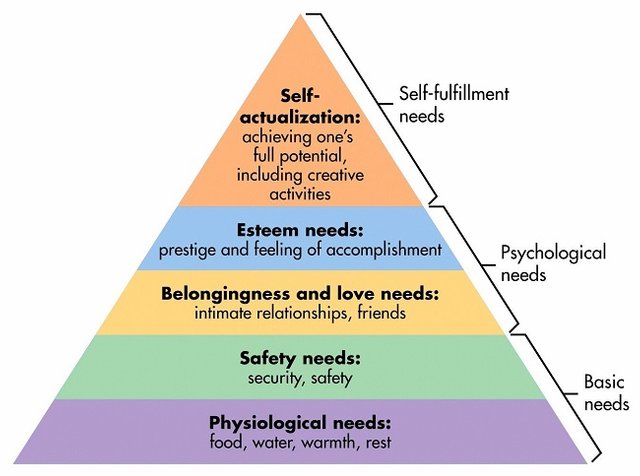Abraham Maslow's Motivation Theory
Essence of motivation.
The motif is an intrinsically incited by the individual motivation for action - the excitor, the reason for satisfying the realized need. In short, the motivation deals with the "why" questions of behavior. Motivation is the process of a voluntary decision by the individual for a certain purposeful action or inaction in a certain situation. It refers to the internal states of the organism, which lead to provocation, stubbornness, energy supply, and direction of behavior. At the core of the motivation process are the human needs. They are the criterion, the motive that each individual leads in making a specific solution to a given situation. When dealing with human needs, they have to be seen in several aspects, namely: they are very dynamic, always subjective and relative, they are varied and depending on the purpose and subject of motivation. Motivation has two forms:
- external motivation - what do you do for people or to motivate them;
- internal motivation - self-inflicted individual factors that influence him to behave in a certain way.

Abraham Maslow's Motivation Theory.
Brief biographical notes:
Abraham Maslow was born in 1908 in New York. As he himself says, he has had a difficult childhood in the family of an uneducated, fanatically religious mother, a nigger father, and in an environment that does not approve of his Jewish background. He graduated in psychology and defended his Ph.D. at the University of Wisconsin. Returning to New York, he became a lecturer, his professional environment includes Hitler's refuge, A. Adler, K. Horney, R. Benedict, M. Werthheimer. I mention this fact as much as it is important for the crystallization of his ideas. He works as a professor at Brandey University, is actively involved in a number of psychological societies, issues a journal on humanitarian psychology. He suddenly died of a heart attack at the age of 62 in the 1970s. In the early 1960s, a group of psychologists sharing common ideas on human development with the lead initiative of Abraham Maslow (at the time leading the Department of Psychology at the University of Brandes) united in a scientific movement. They call it a humanistic direction in the theory of personality, also known as the psychology of the third power (the first two "forces" are psychoanalysis and behaviorism as leading psychological stances). As a philosophical methodological foundation of the new movement is placed existentialism (S. Kirkegore , K. Yerperspers, M. Heidegger), and his psychological foundations are related to the ideas of E. From, A. Adler, G. Olford, K. Rogers, V. Frankl and R. May.
In Maslow's extremely popular theory of motivation and hierarchy of needs, the following principles are laid down, which will be presented below. At the core of motivation are the needs. They are basically organized into a hierarchical system - graphically represented as a pyramid consisting of five layers. Basic (the basis of the pyramid) are the physiological needs - need for food, water, oxygen, sleep, physical activity, sensory stimulation, etc. The second layer includes safety and protection needs - organization, stability, order and security. The third, apparently less than the previous one, is the need for belonging and love. Here are the needs related to the necessity of communication, affection and love, belonging to a community, etc. Below the pyramid, there is a layer of needs of self-respect - to respect yourself and to be respected by others. And top of the pyramid is the need for self-actualization - the need to fully develop and realize your needs, to achieve the maximum you are capable of. A basic principle of the Maslow scheme is that the needs of the previous lower levels should be met in order for the motivation to meet the need for a higher level to emerge. Maslow admits exceptions to this principle, namely to talented people, to highly motivated people, etc. The hierarchical system of needs is common to all, but for every person it can be manifested in an individual way.

Another principle is that, if the circumstances of the circumstances do not meet the needs of the previous, lower layer, then one limits the satisfaction of needs to a higher level and concentrates its efforts on the lower one to restore the satisfaction of the respective needs. For example, if a person has risen to the level of self-actualization, but loses his job and remains a long time without income, ie the satisfaction of second-level needs is disrupted, the satisfaction of needs related to self-actualization is severely limited. Efforts are focused on meeting the needs of a second level, and only after they are permanently recovering, they can return to the needs of the next levels. Of course, it is not necessary to 100% satisfy one level to go to the next one. Maslow estimates the following ratio to meet the needs of the five levels in a normal average individual: 85% - physiological; 70% - safety requirement; 50% - affiliation and love; 40% - need for self-respect; 10% - need for self-actualization. The motivation to meet the needs is divided into two sub-types: deficient motivation (motivation) and motivation for development or motivational motivation (B - motivation). The needs for B - motivation are also found under the name metaboites. E - the motives generally include the first two levels of the hierarchical system, and the B motives refer to the next three. E - motivation is related to the accumulation of deficits, deficits with the main purpose - restoration of homeostasis. B - the motives are aimed at realizing the potential opportunities of the individual, enriching the life experience. And as learning new things, the realization is related to tension and conquest of new "territories", it is not a matter of restoring homeostasis, but rather of striving to continually disturb it and move on to the next, high level.
Maslow logically develops this scheme and comes to the conclusion of two basic lifestyles - a deficient way or E - life and a living lifestyle or B - life. Deficient lifestyles include the motives related to meeting physiological needs and safety needs. The striving to maintain a calm balance without a particular desire for development and change. The way of life implies motivation for development, for realization of the personality capabilities. According to Maslow, however, the most important difference between self-actualizing people is the character of their basic motivational processes. While in ordinary people motivation is related to the satisfaction of current needs (deficit motivation), in self-updating people motivation is mainly related to development. "They work, they are old and ambitious, albeit in an unusual sense. For them, motivation is simply the development of character, its expression, maturation and growth, in a word self-actualization ". This Maslow's stance on personal development as the main motive for self-actualization is at the service of examining culture through subjectivity. E. Maslow is among the few psychologists whose ideas are used in a variety of areas of social life - from education and health to human resources management and management. The main reason behind this is, of course, the extraordinary merit of his theory-I think it lies in Maslow's ability to feel the movement of world civilization towards a new type of society, with new values and fundamental changes in all spheres of human life (Toffler 1991 ) and to create the theory of the chief person in this new society.
Modern theories of creativity also often use postulates from Maslow's theory - an example of this is the theory of multiple intelligence (Gardner 1983). Many of the ideas of modern management are more directly or indirectly related to the basic ones of humanistic psychology. Maslow himself "tries his pen" in this area by creating the famous "Theory Z". The Z-theory for human resource management is based on the holistic human nature and the theory of self-actualization. After Maslow there appeared many management publications that developed Maslow's ideas through the management's prism - the hierarchy of needs, the importance of values, self-actualization, and so on.